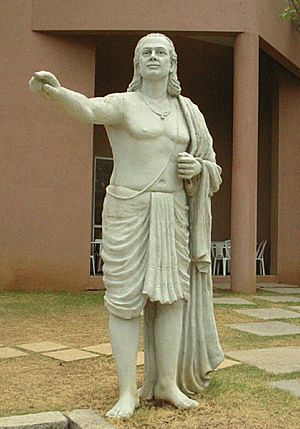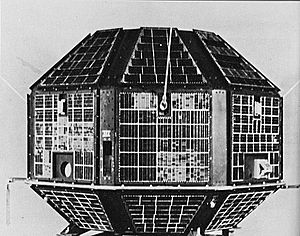Aryabhata facts for kids
Quick facts for kids
Āryabhaṭa
|
|
|---|---|

Statue of Aryabhata at the IUCAA in Pune
|
|
| Born | c. 476 CE |
| Died | 550 CE |
| Academic background | |
| Influences | Surya Siddhanta |
| Academic work | |
| Era | Gupta era |
| Main interests | Mathematics, astronomy |
| Notable works | Āryabhaṭīya, Arya-siddhanta |
| Notable ideas | Explanation of lunar eclipse and solar eclipse, rotation of Earth on its axis, reflection of light by moon, sinusoidal functions, solution of single variable quadratic equation, value of π correct to 4 decimal places, diameter of Earth, calculation of the length of sidereal year |
| Influenced | Bhaskara I, Brahmagupta, Varahamihira, Lalla, Kerala school of astronomy and mathematics, Islamic Astronomy and Mathematics |
Aryabhata (born around 476 CE, died 550 CE) was a brilliant Indian mathematician and astronomer. He made amazing discoveries that changed how people understood the world. His ideas had a huge effect on math and space science, both in India and globally. India's first satellite, launched in 1975, was even named Aryabhata to honor him.
Contents
Who Was Aryabhata?
Not much is known about Aryabhata's early life. Historians believe he was born around 476 CE. This was in a place called Asmaka, which is now part of modern-day India.
It is thought that he later moved to Kusumapura for his advanced studies. He lived there for some time, learning and developing his ideas.
Aryabhata's Amazing Discoveries
Aryabhata had many groundbreaking ideas. He was one of the first to suggest that the Earth spins on its own axis. He also believed that the Earth moves around the Sun. These were very new and bold ideas for his time.
He also figured out how to accurately predict the positions of planets. He explained eclipses using science, not myths. He even calculated the length of a year with incredible precision! He found that a year is 365 days, 6 hours, 12 minutes, and 30 seconds long. This is very close to what we know today.
Contributions to Mathematics
Aryabhata was not just an astronomer; he was also a fantastic mathematician. He created new ways to solve math problems. This included methods for finding square roots and cube roots.
He also worked with trigonometry, which is a branch of math dealing with triangles. He introduced the idea of the sine function. This tool is still used by mathematicians and scientists all over the world.
Aryabhata also made a very good guess for Pi (π). Pi is a special number used to calculate things about circles. He figured it was about 3.1416. This was incredibly close to the actual value. This was a big achievement, as Pi is super important in many math problems.
He also helped develop algebra. He found ways to solve indeterminate equations. These are equations that can have more than one answer. These types of equations are still studied and used in math today.
Aryabhata's Major Works
Aryabhata wrote several important books about math and astronomy. Some of these books are now lost. His most famous work was called Aryabhatiya.
Aryabhatiya is a complete book that covers many topics in math and astronomy. It is divided into different parts:
- Gītikāpāda: This part has introductory verses and important numbers for astronomy.
- Ganitapāda: This section focuses on mathematics. It includes arithmetic, algebra, and trigonometry.
- Kālakriyāpāda: This part deals with how to keep track of time and how planets move.
- Golapāda: This section is about spherical astronomy and how the universe works.
Interesting Facts About Aryabhata
- Aryabhata realized that stars seem to move westward because the Earth is spinning on its axis.
- He also noted that the Moon and other planets shine because they reflect light from the Sun. They don't make their own light.
- Aryabhata Knowledge University in Patna, India, is named in his honor.
- A type of bacteria found in space, called Bacillus aryabhata, is also named after him. It was discovered by Indian scientists in 2009.
See also
 In Spanish: Aryabhata para niños
In Spanish: Aryabhata para niños
- Āryabhaṭa numeration
- Āryabhaṭa's sine table
- Indian mathematics
- List of astronomers § Aryabhata
- List of Indian mathematicians



